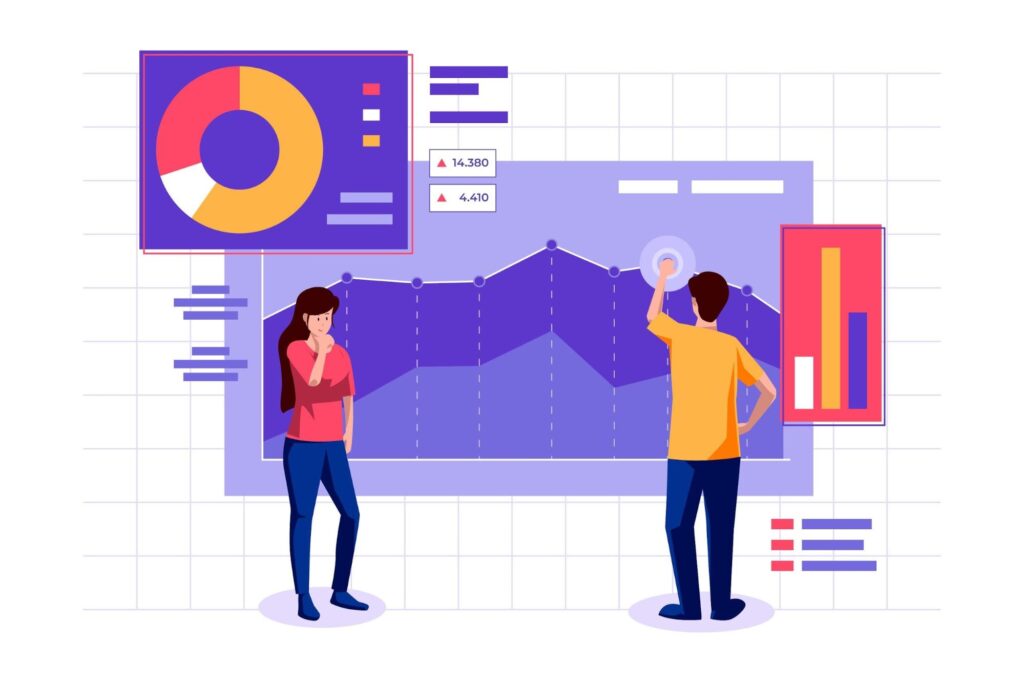Companies are producing content at an unprecedented rate. However, traditional content review processes often struggle to keep up, leading to delays and inconsistencies. Many businesses face challenges such as delayed feedback, style inconsistencies, and bottlenecks in the approval process, all of which can hinder effective content delivery. In fact, only 29% of organizations consider their content strategy highly effective.
To address these challenges, integrating intelligence into content review processes has become essential. Content evaluation serves as a preliminary step, focusing on understanding whether content is effective.
Content review with intelligence refers to the use of AI-powered tools and data-driven insights to automate, optimize, and enhance the content review process. By leveraging AI, businesses can automate repetitive tasks, identify content gaps, and enhance collaboration among teams. This approach streamlines workflows while ensuring that content remains relevant, accurate, and engaging for target audiences.
Understanding Content Review with Intelligence: Smarter Content Strategy for Business
As content demands grow, businesses must evolve beyond manual review processes that slow down production and introduce inconsistencies. Smarter content review leverages AI-powered automation, data-driven insights, and intelligent workflows to create a more efficient, accurate, and scalable review process.
By adopting these innovations, organizations can eliminate bottlenecks and ensure their content meets brand, compliance, and audience expectations without unnecessary delays. AI content review enhances the efficiency and quality of digital content analysis.
Defining Intelligence-Driven Content Review
Intelligence-driven content review is about using artificial intelligence, machine learning, and automation to optimize every stage of the review process. Instead of relying solely on manual oversight, AI-powered tools analyze content in real time, flag inconsistencies, suggest improvements, and ensure alignment with brand guidelines. Teams can focus on strategic tasks rather than getting caught in time-consuming, repetitive work.
The Shift from Manual Processes to AI-Assisted Workflows
Traditionally, content review has been a linear, labor-intensive process requiring multiple approvals across different teams. This often leads to delays, version control issues, and inefficiencies. AI-assisted workflows introduce intelligent automation that streamlines tasks like content tagging, sentiment analysis, compliance checks, and real-time feedback.
Key Benefits of Smarter Content Review Strategies
Organizations that embrace intelligence-driven content review gain a competitive edge by optimizing efficiency and content quality. These benefits include:
- Faster approvals and reduced bottlenecks – AI automates routine checks and recommendations, significantly cutting review times.
- Consistency in messaging and branding – Automated content analysis ensures that all assets adhere to brand guidelines and tone of voice.
- Improved compliance and risk mitigation – AI-powered tools help detect regulatory issues, ensuring content aligns with industry standards.
- Data-driven content optimization – Machine learning insights highlight what resonates with audiences, helping teams refine their messaging.
- Better cross-team collaboration – Centralized platforms powered by AI enhance visibility, enabling seamless feedback and faster decision-making.

By leveraging content review with intelligence, businesses can create a more agile, scalable process that ensures content is high quality and strategically aligned with business goals.
The Challenges of Traditional Content Review
Traditional content review processes are increasingly showing their age. These manual methods, while foundational for years, are fraught with inefficiencies and limitations that can hinder a business’s ability to produce high-quality content at scale.
Manual Review Process and Its Limitations
Traditional content review processes take time and labor. Reviewers must meticulously scan large volumes of text for errors, inconsistencies, and inaccuracies. Manual scrutiny is tedious and prone to human error, leading to missed issues and delayed publication. The sheer volume that needs to be reviewed can overwhelm even the most diligent teams, resulting in bottlenecks that slow down the entire content creation workflow.
Moreover, the reliance on subjective evaluations in traditional review processes can lead to inconsistent feedback and varying levels of content quality. Reviewers may have different standards and interpretations, which can negatively impact overall quality. Inconsistencies can result in a poor user experience and diminish the brand’s reputation.
Search engines prioritize high-quality content that meets user needs and expectations, but traditional content review processes often fall short. They struggle to keep up with the demands of search engines, leading to poor search results and reduced online visibility.
Overcoming Traditional Review Process Limitations
Businesses must adopt a more efficient approach to content review. By leveraging AI-powered content review tools, leaders can streamline their review process, improve content quality, and drive business growth.
AI-powered content review tools can analyze large volumes of text quickly and accurately, identifying errors, inconsistencies, and inaccuracies that human reviewers may miss. These tools can also provide actionable feedback and suggestions for improvement, enabling creators to refine their content and meet business goals.
In addition, content intelligence can help teams develop a more effective content strategy, one that is informed by data and analytics. By analyzing content performance and user behavior, businesses can gain valuable insights into what works and what doesn’t, and adjust their content strategy accordingly.
The Power of Content Review with Intelligence
Integrating intelligence into content review transforms a traditionally fragmented and time-consuming process into a seamless, automated workflow. AI-driven insights enhance speed and improve the accuracy and impact of content, allowing teams to focus on creativity and strategy rather than administrative roadblocks. By eliminating manual inefficiencies, businesses can produce higher quality content at scale while maintaining consistency across channels.
Automating Repetitive Tasks for Faster Approvals
One of the biggest challenges in content review is the time spent on repetitive tasks such as proofreading, compliance checks, and formatting adjustments. AI-powered automation can instantly scan content for grammatical errors, brand inconsistencies, and regulatory compliance, reducing the need for multiple review cycles.
For example, global enterprises use AI-driven content tools to ensure marketing materials align with regional compliance standards, preventing costly revisions and approval delays.

AI-Driven Insights to Reduce Content Bottlenecks
Bottlenecks often arise when content sits idle in review queues, waiting for stakeholder approvals. Artificial intelligence eliminates these roadblocks by prioritizing content based on urgency, suggesting real-time edits, and routing approvals to the right team members.
Consider a large e-commerce company launching seasonal promotions—AI can identify which product descriptions or ads need immediate attention and ensure they’re reviewed and published before peak shopping periods.
Enhancing Collaboration with Smart Workflows
Traditional content review processes often involve back-and-forth emails, multiple file versions, and misaligned feedback. Smart workflows powered by AI provide a centralized system where teams can collaborate in real time, track changes, and maintain a clear audit trail. Additionally, AI content review services allow users to allocate more time to other aspects of their blogging or website management.
A multinational brand, for instance, can use AI-enhanced workflows to manage content localization, automatically flagging translation discrepancies and ensuring brand consistency across global markets.
By leveraging intelligence in content review, businesses accelerate their workflows while enhancing content precision and team collaboration, leading to better performing content and faster go-to-market strategies.
Identifying and Resolving Content Gaps with AI
Even the most well-planned content strategies can suffer from gaps—whether it’s missing key information, inconsistencies in messaging, or content that doesn’t fully address audience needs. Artificial intelligence helps businesses detect and resolve these gaps by analyzing large volumes of content, identifying trends, and offering data-driven recommendations. Every piece of content is optimized for engagement, compliance, and brand alignment before publication.
Detecting Inconsistencies in Messaging and Branding
Maintaining a unified brand voice across multiple platforms can be challenging, especially when content creation is handled by different teams or agencies. AI-driven content analysis ensures that all materials adhere to a brand’s tone, style, and messaging guidelines.
For example, a global financial services company can use AI to scan marketing assets and flag discrepancies in legal disclaimers, ensuring compliance with industry regulations while maintaining a consistent brand voice across regions.
Using Predictive Analytics to Optimize Performance
Without the right insights, businesses risk producing content that underperforms or fails to reach the right audience. Predictive analytics, powered by AI, analyzes past engagement metrics, audience preferences, and market trends to determine what content will resonate best.
A retail brand launching a new product line, for instance, can use AI to assess which messaging styles or content formats have historically driven the highest conversions, allowing them to refine their campaigns before launch.
Personalizing Content Quality for Target Audiences
A one-size-fits-all approach to content is no longer effective. AI enables real-time content adaptation based on user behavior, demographics, and engagement patterns. Consider a B2B technology company that serves multiple industries—AI can help tailor case studies, blog posts, and whitepapers to address specific pain points of different verticals, ensuring each audience receives the most relevant and impactful information.

By leveraging AI to identify and resolve content gaps, businesses can produce more effective, data-driven content that aligns with their brand, meets audience expectations, and drives measurable results.
Accelerating Content Review with Centralized Visibility
A major obstacle in content review is the lack of centralized oversight, which leads to delays, redundant efforts, and misalignment across teams. AI-powered tools bring real-time visibility into the content lifecycle, ensuring that all stakeholders can track progress, make informed decisions, and speed up approvals. By consolidating workflows, businesses gain efficiency, improve collaboration, and maintain full control over content performance and compliance.
Unified Dashboards for Real-Time Monitoring
Centralized dashboards powered by AI give content teams a bird’s-eye view of all assets in the review process, highlighting bottlenecks and pending approvals. Instead of manually tracking content status through scattered emails and spreadsheets, teams can see at a glance which pieces are ready for approval and which need revision.
For example, a global consumer brand can use a content intelligence dashboard to oversee campaign assets across different markets, ensuring brand consistency while meeting regional compliance requirements.
Machine Learning-Powered Recommendations for Streamlined Edits
Waiting for multiple rounds of feedback can slow down content production, but AI can help by proactively suggesting edits based on brand guidelines, readability, and past performance metrics. This reduces reliance on manual revisions and ensures content is optimized before reaching final review stages.
A practical tip: Use AI-driven insights to fine-tune messaging for different audience segments, improving engagement rates without extending the review timeline.
Version Control and Compliance Checks Made Easy
Managing multiple versions of content—especially in regulated industries—can be a logistical nightmare. AI automates version tracking, ensuring that only the latest, approved version is distributed.
Additionally, built-in compliance checks help flag risks before content is published. For example, a healthcare company producing educational materials can rely on AI to verify that regulatory disclosures are correctly applied, avoiding costly legal revisions.
By leveraging centralized visibility, businesses can eliminate silos, reduce approval delays, and maintain tighter control over content workflows, leading to more efficient and error-free content review cycles.
Implementing Smarter Tools for Scalable Content Operations
As content production scales, manual processes become increasingly unsustainable. AI streamlines reviews and helps organizations scale content operations without sacrificing quality. By integrating automation, predictive insights, and intelligent workflows, businesses can manage higher content volumes while maintaining consistency, compliance, and audience relevance.
Leveraging AI to Prioritize High-Impact Content
AI helps teams focus on assets that drive the most value. By analyzing performance data, AI can prioritize content updates, repurpose high-performing materials, and flag low-impact content for revision.
A helpful tip: Regularly audit your content library with AI to identify underutilized assets that can be optimized or repurposed for better engagement.
Intelligent Automation for Seamless Multi-Channel Approvals
Publishing across multiple platforms requires a coordinated approval process, which can be difficult to manage manually. AI streamlines approvals by automatically routing content to the right stakeholders based on predefined rules.
For example, a retail company launching a new product campaign can use AI to ensure all digital ads, social media posts, and e-commerce descriptions go through the correct legal and marketing approvals simultaneously, cutting down delays.
Improving Cross-Team Collaboration with Data-Backed Decisions
Data-driven decision-making is key to scaling content operations. AI analyzes team workflows, identifies process inefficiencies, and suggests optimizations to improve collaboration. A large enterprise, for example, can leverage AI insights to pinpoint where content approvals get stuck and implement workflow adjustments that reduce unnecessary back-and-forth between departments.
By integrating intelligence into content operations, organizations can achieve greater efficiency, ensure content remains impactful, and future-proof their workflows for continued business growth.
Enhancing Digital Asset Management with Content Review Intelligence
As organizations manage an ever-growing volume of digital assets, ensuring that content remains accessible, compliant, and up-to-date becomes complex. Integrating content review with intelligence into digital asset management (DAM) systems allows businesses to streamline asset organization, optimize searchability, and maintain version control with AI-driven efficiency.
AI-Powered Metadata Tagging for Faster Discovery
Manually tagging assets with metadata is time-consuming and prone to inconsistencies, making it difficult for teams to find the right content when needed. AI automates this process by analyzing images, videos, and documents, generating accurate, searchable metadata based on content context.
For example, a global media company can use AI to auto-tag video files with relevant keywords, making it easier for editors to retrieve specific clips for future campaigns.
Intelligent Versioning to Prevent Outdated Content Use
One of the biggest challenges in digital asset management is version control—outdated assets often get mistakenly used in marketing or customer-facing materials. AI-powered DAM solutions track content revisions in real time, flag outdated assets, and suggest the latest approved versions. A multinational brand, for instance, can prevent compliance issues by ensuring only the most recent, legally approved product imagery is available for use across global campaigns.
Automated Compliance Checks for Brand and Legal Consistency
Ensuring brand consistency and regulatory compliance across digital assets is critical, particularly in regulated industries. AI enhances DAM by automatically reviewing assets for adherence to brand guidelines, copyright policies, and industry regulations. For example, a pharmaceutical company can use AI to detect if expired regulatory language appears in archived marketing assets, preventing legal risks before content is repurposed.
By integrating intelligent content review into DAM systems, businesses can improve asset accessibility, compliance, and usability—ensuring their digital content remains an asset rather than a liability.
Embrace Content Review with AI-Driven Intelligence
Quality content demands agility, precision, and scalability—traits that traditional content review processes often lack. By integrating AI and automation, businesses can eliminate bottlenecks, accelerate approvals, and ensure content remains consistent, compliant, and engaging across all channels.
As organizations scale their content operations, adopting intelligent content review solutions becomes essential for maintaining efficiency and quality. AI-powered insights help teams identify content gaps, optimize performance, and ensure brand consistency while reducing manual oversight. By centralizing visibility and leveraging smart automation, businesses can streamline collaboration and deliver high-impact content faster.Aprimo empowers organizations with AI-driven content intelligence, enabling seamless digital asset management, automated content workflows, and real-time performance insights. With advanced AI capabilities, Aprimo ensures that every asset is optimized, compliant, and ready to drive engagement. Book a demo today and discover how Aprimo can help you transform your content operations with intelligent automation.


